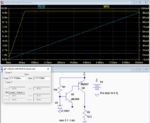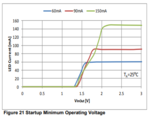hm_fa_da
Full Member level 5

Hi all,
I'm trying to design a precision active current limiter circuit to limit output current down to 100mA.
I saw many different circuits in net, some made by BJT transistors which are not precision enough.
I don't have much space on my PCB, so priority of the design is being simple and low size.
Do you have any suggestion for compact ICs to limit the desired current value by a setting resistor only ... ?
I found this circuit useful:

As you see it has only 2 components, so low size and compact enough, but to achieve to 100mA limitation, 12.5ohm Resistor should be used which makes high voltage drop ... (1.25V drop).
The other way is to use op-amps driving a mosfet ... but those circuits also have many components which is not good for my case.
The best solution would be some simple circuit like the picture i sent (but with lower V drop) or a compact controllable IC for current limitation ...
I'll be thankful for your suggestions.
I'm trying to design a precision active current limiter circuit to limit output current down to 100mA.
I saw many different circuits in net, some made by BJT transistors which are not precision enough.
I don't have much space on my PCB, so priority of the design is being simple and low size.
Do you have any suggestion for compact ICs to limit the desired current value by a setting resistor only ... ?
I found this circuit useful:

As you see it has only 2 components, so low size and compact enough, but to achieve to 100mA limitation, 12.5ohm Resistor should be used which makes high voltage drop ... (1.25V drop).
The other way is to use op-amps driving a mosfet ... but those circuits also have many components which is not good for my case.
The best solution would be some simple circuit like the picture i sent (but with lower V drop) or a compact controllable IC for current limitation ...
I'll be thankful for your suggestions.




